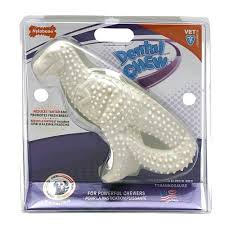Safe Dental Chews
Chewing is a natural behavior for dogs, and it does have positive effect on dental health. Since many of the chewing teeth are beyond our reach to brush, I like to think of chewing as the dog brushing his own teeth! Some dogs are such intense chewers that pet owners struggle to find objects that that last longer than a few minutes. So we look for more durable chews. They cost a little more, but they last longer. Seems logical, right?
The problem with hard chew objects is that they greatly increase the chance of tooth fracture. When powerful jaws clamp down, the softest structure breaks, and that very well could be a tooth! I commonly encounter fractured chewing teeth during routine physical examinations. It is a sad thing, because a fractured tooth is a dead tooth. Dead teeth will eventually abscess. The abscesses begin deep with

in the bone, at the tip of the tooth root. Dogs are quite stoic. They continue to eat until the pain becomes unbearable. We are not aware of the dog’s pain until the abscess becomes a full-blown, face-swelling, pus-draining mess. The point of this is not to discuss tooth abscesses--it is to prevent them. We can keep our dogs’ teeth safe by choosing appropriate chew objects.
Don’t count on the marketplace to help you. Many inappropriate and dangerous items are available for purchase, including some manufactured by reputable companies and clearly labeled “Dental Chew”. When selecting chew toys, look for products with some flexibility, or “give” when pressed. Could you bite down on it yourself without discomfort? Would it hurt if you whacked your funny bone with it? The veterinary dental community continues to look for the perfect guideline, so to make things easier for you (and to save your funny bone), here is the “NO” list for dental chews:
Now for the “YES” list:
Rawhide (single layer strips or chips)
CET Hextra Chews (rawhide imbedded with an oral antiseptic)
OraVet Chews (contains a substance to prevent plaque from adhering to the teeth)
Milkbone Brushing Chews (has the VOHC seal of approval)
Greenies (VOHC approved)
Rubber toys like “Kongs” (can add peanut butter or other foods for flavor)
Rope toys
Edible chews (compressed starch)
Use caution with edible chews, as they start out rather hard, but soften. If your dog likes to dive in and chew with vigor, consider softening them a bit in some warm water before offering them to the dog. With any product, first use them under supervision to make sure the dog is not trying to swallow large pieces. Edible chews will dissolve in the stomach, but a chunk lodged in the throat or esophagus is an emergency.
